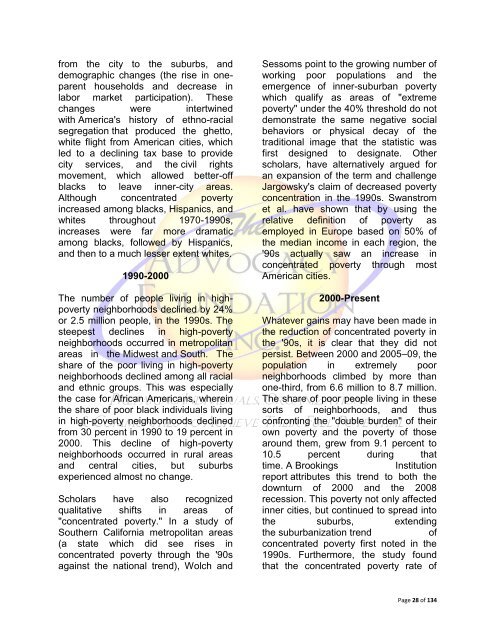Concentrated Poverty
Concentrated Poverty
Concentrated Poverty
Create successful ePaper yourself
Turn your PDF publications into a flip-book with our unique Google optimized e-Paper software.
from the city to the suburbs, and<br />
demographic changes (the rise in oneparent<br />
households and decrease in<br />
labor market participation). These<br />
changes were intertwined<br />
with America's history of ethno-racial<br />
segregation that produced the ghetto,<br />
white flight from American cities, which<br />
led to a declining tax base to provide<br />
city services, and the civil rights<br />
movement, which allowed better-off<br />
blacks to leave inner-city areas.<br />
Although concentrated poverty<br />
increased among blacks, Hispanics, and<br />
whites throughout 1970-1990s,<br />
increases were far more dramatic<br />
among blacks, followed by Hispanics,<br />
and then to a much lesser extent whites.<br />
1990-2000<br />
The number of people living in highpoverty<br />
neighborhoods declined by 24%<br />
or 2.5 million people, in the 1990s. The<br />
steepest declines in high-poverty<br />
neighborhoods occurred in metropolitan<br />
areas in the Midwest and South. The<br />
share of the poor living in high-poverty<br />
neighborhoods declined among all racial<br />
and ethnic groups. This was especially<br />
the case for African Americans, wherein<br />
the share of poor black individuals living<br />
in high-poverty neighborhoods declined<br />
from 30 percent in 1990 to 19 percent in<br />
2000. This decline of high-poverty<br />
neighborhoods occurred in rural areas<br />
and central cities, but suburbs<br />
experienced almost no change.<br />
Scholars have also recognized<br />
qualitative shifts in areas of<br />
"concentrated poverty." In a study of<br />
Southern California metropolitan areas<br />
(a state which did see rises in<br />
concentrated poverty through the '90s<br />
against the national trend), Wolch and<br />
Sessoms point to the growing number of<br />
working poor populations and the<br />
emergence of inner-suburban poverty<br />
which qualify as areas of "extreme<br />
poverty" under the 40% threshold do not<br />
demonstrate the same negative social<br />
behaviors or physical decay of the<br />
traditional image that the statistic was<br />
first designed to designate. Other<br />
scholars, have alternatively argued for<br />
an expansion of the term and challenge<br />
Jargowsky's claim of decreased poverty<br />
concentration in the 1990s. Swanstrom<br />
et al. have shown that by using the<br />
relative definition of poverty as<br />
employed in Europe based on 50% of<br />
the median income in each region, the<br />
'90s actually saw an increase in<br />
concentrated poverty through most<br />
American cities.<br />
2000-Present<br />
Whatever gains may have been made in<br />
the reduction of concentrated poverty in<br />
the '90s, it is clear that they did not<br />
persist. Between 2000 and 2005–09, the<br />
population in extremely poor<br />
neighborhoods climbed by more than<br />
one-third, from 6.6 million to 8.7 million.<br />
The share of poor people living in these<br />
sorts of neighborhoods, and thus<br />
confronting the "double burden" of their<br />
own poverty and the poverty of those<br />
around them, grew from 9.1 percent to<br />
10.5 percent during that<br />
time. A Brookings<br />
Institution<br />
report attributes this trend to both the<br />
downturn of 2000 and the 2008<br />
recession. This poverty not only affected<br />
inner cities, but continued to spread into<br />
the suburbs, extending<br />
the suburbanization trend<br />
of<br />
concentrated poverty first noted in the<br />
1990s. Furthermore, the study found<br />
that the concentrated poverty rate of<br />
Page 28 of 134

















